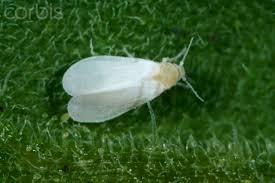Greenhouse whitefly Trialeurodes vaporariorum
Greenhouse whitefly were first observed in tomatoes in America in 1870, and since then have been found to be major pests in a wide variety of vegetable and ornamental crops around the world.
Life-cycle and appearance
Adult whitefly tend to lay their eggs onto the soft young plant growth at the top of the plant. When eggs are first laid, they are white in colour but then turn black prior to hatching. Once hatched, the whitefly larva is able to move around on the leaf for about 1 day. After moving away from the egg, the larva attaches itself to the leaf and remains sedentary, feeding from the plant until it finally moults into a pupa. The nymphal stage starts off as a flattened oval disc on the leaf. Later the developing whitefly stops feeding but swells and develops a distinct vertical body wall with fine spikes over its body, giving a “crown like” appearance. Whitefly adults begin feeding soon after hatching and continue to feed from plants until they die.
Females will start laying eggs about 2 days after hatching as adults. Unmated females lay male eggs, while mated females lay both female and male eggs. The two most important factors affecting whitefly population growth are temperatures and the plant host. Greenhouse whitefly will continue to breed throughout the year in temperate climates. Whitefly eggs can survive more than 15 days at –3°C. The number of eggs laid by a single female varies greatly and will depend on the host plant species, and can even vary between varieties of plants within a species. For example, whitefly females will lay more eggs on beef-steak tomatoes than on many other tomato varieties. Whiteflies that have originated on a capsicum crop will lay more eggs on another capsicum crop than whiteflies that have been reared on a different plant species. At 22°C a whitefly female can lay on average around 350 eggs in her life time on eggplants (aubergines), 160 eggs on cucumbers and only 20-30 on capsicums.

Related products
- Encarsia
- Eretmocerus
- Ladybirds
- Lailae
- Monty
- Nesidiocoris
- Yellow sticky traps & hand lenses
Related crops
- Berryfruit
- Flowers/ornamentals
- Greenhouse capsicums
- Greenhouse cucumbers
- Greenhouse eggplants
- Greenhouse tomatoes
- Herbs
- Nursery
- Strawberries





